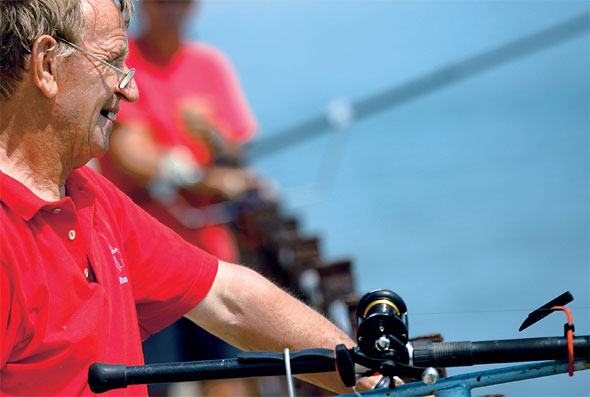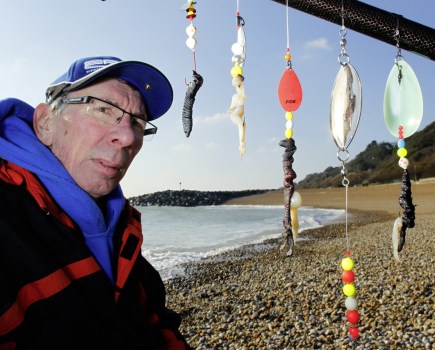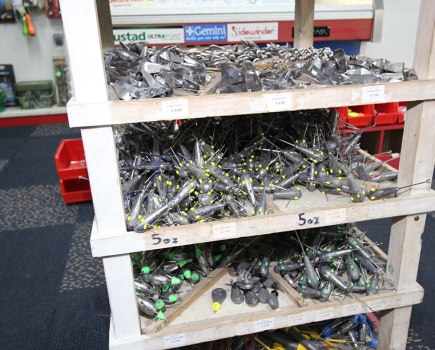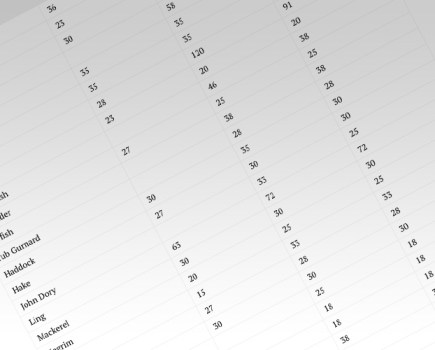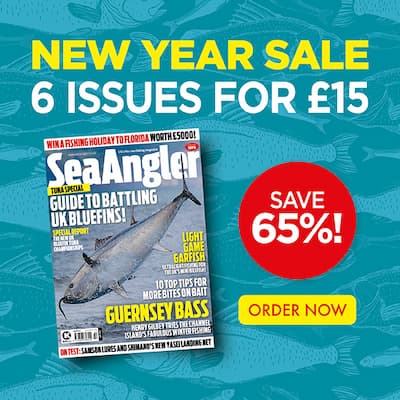The best pier fishing of the year starts when summer slips into September and October. As warm-water fish overlap with the incoming cold-water species it means boom times ahead, so Alan Yates offers advice to novices and pier regulars on tactics, tackle and baits…
PIERS ARE OBVIOUS magnets to sea anglers because they give easy and instant access to deep water, with no need to cast far and lots more fish on offer than from the beach.
This has made piers increasingly popular and crowded, especially for beginners. But as autumn looms the holiday feathering hoards leave many piers to proper sea anglers. So, with a seasonal Indian Summer weather window giving mild and settled conditions, it is time to make hay. Don’t miss it.
There are two types of pier – the walled and stilted. Both provide a complex habitat and food chain or larder for a mix of sea species. Piers are like a man-made mini reefs offering shelter, weed growth and food attracting marine animals and fish. It’s a complete standalone marine environment in what would be, in some cases, a flat featureless sea bed.
This means that fishing from the pier requires a mix of angling knowledge and skills. It’s the most complex branch of sea angling, which is why many novices drawn to the attractions of the pier struggle to cope.
Biggest challenge for many is strong tide; walled piers in particular oppose or actually try the block the tidal fl ow, which increases in strength where it meets the wall.
Stilted piers allow the current to fl ow under them, so tide is not so strong, but there is the ever-present danger of tackle snagging and tangling on the leggy structures.
Both types of pier have fish-holding areas, such as alongside the wall or piles, on the sea bed around, in or under the pier or near the surface under weed and cross beams.
A range of tackle and tactics are needed to counter these conditions, while understanding where the various species might be feeding, lurking or shoaling is crucial to the techniques adopted. This is further complicated by the fact that species are seasonal.
Use tackle that is effective
PIER fishing doesn’t require specialist tackle with a 12 or 13ft beach casting rod capable of launching 4-6oz of lead weight suitable for most fishing challenges.
Specialist lighter rods may be required where overhead casting is banned, for boom hanging, or casting a float on the surface. In these situations light mono or braid line may be preferred, but in general a beachcaster and reel balanced with 15lb mono and a 60lb shockleader will get you started.
Terminal tackle essentials are wired grip leads for combating the tide with fixed wire styles in the 5-8oz range essential for many walled piers where the tide’s strength is magnified by the wall.
Rigs used for beach fishing are suitable, although shortening them will make casting easier from a pier deck and ensures the baits are close to the sea bed. The angle of your line to the water can lift baits off the bottom. A favourite rig is the one-up, one-down mono paternoster. This is fully explained on page 57. Float rigs and traces using booms for fishing alongside the wall are particularly effective for some species.
Other tackle essentials are a secure way of clamping your rod to the pier railings or wall and having a landing net or drop net handy for landing big fish.
When and where to fish
THE attraction of pier fishing is the fact there’s always water to put bait in, although fish are most active at certain states of the tide. Most piers fish best during the flood or ebb tide run, while some produce their best results during a spring tide series and others during a neap tide sequence.
Identifying suitable tides is part of gathering local knowledge and, when this coincides with dusk or dawn, catches are likely to peak. The end of the pier attracts lots of novices because it offers the deepest water, which everyone thinks holds the most fish. More productive is consideration of the recent results from the pier and any fish-holding features. Lots of walled piers produce back eddies, which collects food and the fish know this.
Many piers have holes or weed fringes where species take up residence or shelter, while fallen debris cancreate shelter. Food and discarded bait is also a big attraction.
Most reliable way to find the hot spots is to ask, although in many cases the crowd of anglers give the spot away.
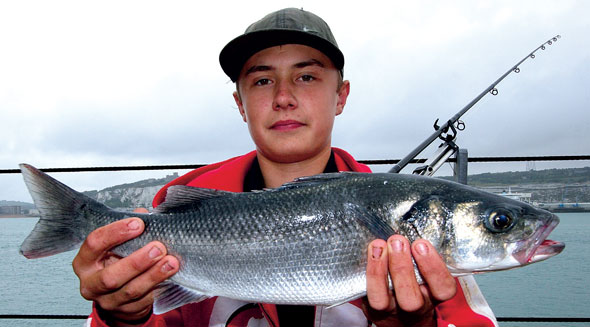
Baits and tactics
CLEAR water is essential for catching mid-water species, such as mackerel, mullet, garfish, scad, pollack and others.
Boom rigs worked alongside the wall with a head-hooked ragworm left to wriggle attractively lures fish, as does a thin slice of a mackerel’s silver underbelly, which can look like a wriggling sandeel in the tide.
A special pier rod-rest to hold the rod out from railings or wall works well; the latest sea quivertip rods and braid line are the most efficient tackle for this method.
A favourite way of fishing on stilted piers is to allow the bait to drift back under the pier between the piles. Getting the amount of lead right so that movement is under control is important. Long snoods that place baits away from the mainline and lead are best.
Coloured water and surf attracts many of the bottom-feeding species, such as bass, soles, pout, dabs, dogfish and codling. Here a bait like lugworms, squid, fish or crab fished hard on the sea bed works best, while cocktails are especially effective from piers.

Lugworms will catch bottom-feeding species
Pier stems come into their own in a rough sea with the fish often more active near surf than the pier end, which offers more action when it is calm or dark.
Casting is important, often more in terms of accuracy and combating tide with a grip lead than sheer distance. Learn to cast slightly uptide to compensate for tidal flow as the lead sinks and use a weight that sinks quickly and holds bottom efficiently.
There is little need for complicated clippeddown terminal rigs, while short wire booms can be used to lay baits hard on the sea bed.
If using small hooks go for a strong pattern and if fish have to be lifted use strong hook snoods and extend the length of the shockleader so it can be used to lift the fish up to the pier deck or top of the wall.
A float can be used to target mackerel, garfish and wrasse. Try either a fixed float on a spinning rod or a float set-up slid down the mainline while your main rig is on the bottom.
A mixed sea bed can pose a problem with tackle snagging, although being above the snag does help escape it. Lost tackle is a major snag problem so don’t use a breakout lead that can easily become trapped in lost leaders. Instead use soft fixed wires bent in a U-shape, which will allow them to spring out and escape most of the snags.
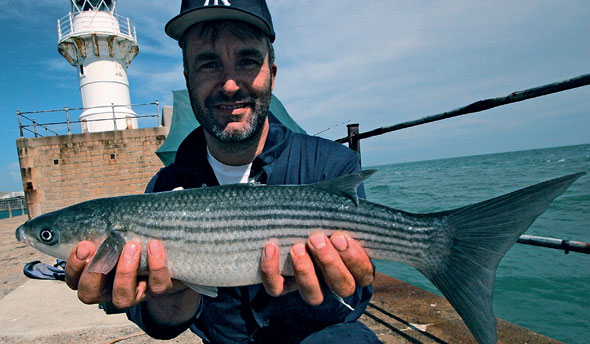
Suspending a bread bag close to the water’s surface will attract both mullet and garfish to your bait.
 BE A FRIENDLY AND THOUGHTFUL PIER ANGLER
BE A FRIENDLY AND THOUGHTFUL PIER ANGLER
- If you are a pier novice watch how the regulars fish; many are only too willing to offer you some advice and encouragement.
- Fishing spots are claimed on a first-come first-served basis, so don’t muscle in on others or reserve places for mates arriving later.
- Don’t take up more than your share of room with your gear. Keep all your kit tidy and out of the way of pedestrians, who may not understand what you are doing.
- Casting is a major danger and it’s important to use common sense. Piers are not the place for a full pendulum or dangerous power casting styles. Ensure that the tackle you use is safe and includes a shockleader, even if you are using an overhead cast and a 4oz sinker. Look before you cast and remember non- anglers are not always aware of the dangers.
- Casting tangles are best sorted before they happen, so keep an eye on your gear where it enters the water. If lines cross, sort them out before the problem gets worse.
- Respect the pier. Don’t cut bait on seats, damage equipment or abuse the furniture. Don’t urinate on the pier.


